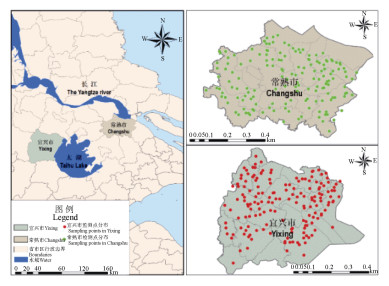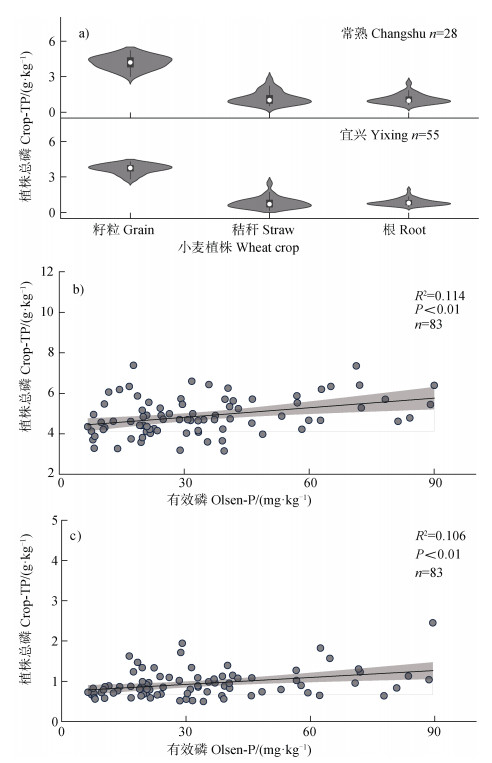2. 中国科学院大学, 北京 100049
2. University of the Chinese Academy of Sciences, Beijing 100049, China
磷作为影响农作物生长的三大营养元素之一,也是农业生产中最重要的养分限制因子。为了维持作物高产,农业生产中需要大量施用磷肥来保证土壤有效磷库。但土壤中大量盈余的磷素可通过地表径流、土壤侵蚀以及渗漏淋溶等途径流失,进而加重水环境污染负荷[1-3]。农田生态系统中的磷资源浪费以及造成的环境风险在长江流域尤其突出[3]。长江流域主要以水旱轮作为主。水稻产量占全国70%,与其他农作物(如小麦、油菜、各种蔬菜等经济作物)形成了独特的水旱轮作种植模式。这也直接导致土壤磷的有效性随着水稻土特殊的氧化还原过程的交替发生而改变,给长江流域水环境安全带来负荷[4]。据国家长江生态环境保护修复联合研究中心调查结果,磷污染已成为制约长江流域水环境质量的主要影响因素[5-6],其中农业源总磷排放量占各污染源磷排放总量的68%,成为区域污染物的主要来源[7]。因此,区域农田土壤磷库的基础调查工作对于了解土壤磷富集程度以及评估农田磷环境风险具有非常重要的理论和现实意义。
近年来,国内外学者越来越关注土壤磷含量空间分布格局和变异特征的研究。例如,MacDonald等[8]和Sattari等[9]通过计算全球农业生态系统的磷平衡,认为农田土壤磷分布极不均衡,部分地区尤其是亚洲耕地土壤磷积累呈增加趋势。Gao等[10]和Chen等[11]通过调查四川盆地紫色土养分变化特征,发现母质和土地利用类型对全磷的空间变异性起主要作用。詹秋丽等[12]探讨了福建耕地土壤磷素富集空间差异,认为全省92.8%的耕地有效磷处于不同程度富集状态。因此,土壤磷素的空间分异特征是制定养分优化管理措施的重要前提[13]。
农田土壤磷的流失风险主要受土壤磷素库容大小、形态转化以及有效性影响。水稻土作为长江流域比较典型的土壤类型,土壤磷的有效性及转化过程也比较复杂[14]。以往关于土壤磷研究主要围绕化学连续提取测定形态展开,不能充分反映土壤根际过程[15]。考虑微生物分泌有机酸、酸性磷酸酶等活化磷的表征形态,DeLuca等[16]模拟微生物和作物根系的磷矿化作用,基于磷素生物有效性的分级方法(biologically based P,BBP)对土壤不同形态磷素的生物有效性进行评价,可应用于复杂的景观尺度[17]。太湖流域位于长江下游,近年来水体富营养化问题一直比较突出且具有代表性。因此,本文选取太湖流域典型农田土壤及对应植株为研究对象,基于系统随机布点法采样,研究土壤全磷及有效磷时空演变特征;同时基于BBP方法进行土壤磷素生物有效性研究,探求土壤磷素的环境阈值,以期为太湖流域养分优化管理及生态环境治理提供基础数据参考。
1 材料与方法 1.1 研究区域概况选取太湖流域稻麦轮作典型代表区域——宜兴市、常熟市农田土壤作为研究对象。其中宜兴市(31°07′N~31°37′N,119°31′E~120°03′E)位于太湖流域西北部,东临太湖,年均气温16.5℃,年降水量约1 230 mm;常熟市(31°30′N~31°50′N,120°33′E~121°03′E)位于太湖流域北部,东北毗邻长江,年均气温16.9℃,年均降水量约1 136 mm。两市均属于典型稻麦轮作农田,土壤类型主要为水稻土。
1.2 样品采集与制备土壤及植物样品采集工作于2018年5月进行。采用系统随机布点法采集农田土壤(小麦收获期)样本319份。具体采样位点如图 1所示。

|
图 1 太湖流域典型农田土壤样本采集分布示意图 Fig. 1 Locations of the monitoring sites in the Taihu Lake Region |
其中,常熟市156个农田土壤样本,分别位于虞山镇城区、辛庄镇、尚湖镇海虞镇、梅李镇、碧溪新区、古里镇、沙家浜镇、支塘镇、董浜镇10个乡镇;宜兴市163个农田土壤样本,分布在万石镇、周铁镇、宜城街道、芳桥镇、和桥镇、屺亭街道、高塍镇、新建镇、官林镇、杨巷镇、官林镇、徐舍镇、西渚镇、太华镇、丁蜀镇、新街街道、张渚镇、湖㳇镇18个乡镇。每个采样点采集混合样品,利用五点法采集0~20 cm表层土壤构成该样点混合土样。在水旱轮作农田中选取具有代表性的土壤样本对应的小麦收获期植物样本83份,其中常熟市28株,宜兴市56株,分成籽粒、秸秆、根三部分。在采样过程中记录经纬度及相关采样信息,同时进行农户抽样调查工作,调查内容包括种植方式、种植面积、大概产量、施肥种类、施肥量等基本信息,并做详细记录。
1.3 土壤与植物样品分析将样品带回实验室,新鲜土壤样品供磷素生物分级实验使用,剩余风干、过筛处理后待进一步分析使用。供试土壤样品分析均采用常规分析方法[18]。土壤pH采用pH计(Thermo ORION STAR A211,美国)测定[w(土):V(水)为1:2.5];土壤全氮采用燃烧法—碳氮元素自动分析仪(PRIMACS SNC90-IC-E,德国)测定;土壤全磷采用H2SO4- HClO4消煮提取—钼蓝比色法(紫外分光光度计(UVmini-1240,日本))测定;土壤有效磷采用NaHCO3(pH 8.5)浸提—钼蓝比色法测定。土壤磷素有效性采用DeLuca等[16]提出的基于生物有效性的磷素分级方法。简要步骤为:称取0.5 g新鲜土于15 mL离心管中,加入10 mL提取液,含0.01 mol·L–1 CaCl2、0.01 mol·L–1柠檬酸、0.02 EU·mL–1酶(含酸性磷酸酶、碱性磷酸酶和植酸酶)和1 mol·L–1 HCl,180 r· min–1往复震荡3 h后离心,取上清液通过0.45 μm微孔滤膜后钼蓝比色法测定。
采集整株小麦作为植株样品,带回实验室用洁净的小刀将地下部分(根)、地上部分(秸秆)及籽粒分开,将部分根、所有茎叶和籽粒样品置于烘箱中,于105℃下杀青2 h,以70℃烘干至恒重,研磨过筛备用。植株全磷含量采用H2SO4-HClO4消煮提取—钼蓝比色法测定[18]。
1.4 数据处理针对土壤Olsen-P、BBP方法提取不同形态磷素以及植株全磷之间关系采用SPSS 21.0软件进行皮尔森(Pearson)相关分析。利用Origin 2021进行绘图。应用ArcGIS 9.2中Geostatistical Analyst模块,采用克里金(Kriging)方法绘制太湖流域水稻产区常熟、宜兴市采样点分布示意图。
2 结果与讨论 2.1 太湖流域农田土壤磷库时空变异太湖流域常熟、宜兴两市分别采集的农田土壤样本基本理化性质如表 1所示。其中土壤pH变化范围在4.56~8.35,土壤全氮及全磷含量分别为0.96~2.78 g·kg–1以及0.28~1.93 g·kg–1。全磷(TP)及有效磷(Olsen-P)含量如图 2a、图 2b所示。常熟市及宜兴市的土壤全磷含量范围分别为0.46~1.93 g·kg–1及0.28~1.92 g·kg–1(常熟市变异系数为25.4%,n=156;宜兴市变异系数为35.9%,n=163),均值分别为0.87 g·kg–1及0.69 g·kg–1。常熟市及宜兴市土壤有效磷含量范围分别为2.19~112.5 mg·kg–1及5.21~109.7 mg·kg–1(常熟市变异系数为63.9%,n=156;宜兴市变异系数为64.6%,n=163),均值分别为37.6 mg·kg–1及29.8 mg·kg–1。
|
|
表 1 太湖流域常熟、宜兴土壤样本基本理化性质 Table 1 Soil physicochemical properties in the Taihu Lake Region |

|
图 2 太湖流域典型农田土壤全磷(TP)及有效磷(Olsen-P)随时间尺度变化以及相关性 Fig. 2 Concentration of soil TP and Olsen-P in paddy soils of the Taihu Lake Region |
结合分析对比第二次全国土壤普查数据(1980s,《土壤志》[19-20],常熟市n=82,宜兴市n=50),以及2009年对太湖流域常熟(n=200)、宜兴(n=200)两市分别采集的土壤样本数据[21],结果表明:两市土壤有效磷与全磷含量均呈增高趋势,且常熟市增幅高于宜兴市(图 2a、图 2b)。对于常熟市,2018年土壤有效磷平均值相较于1980s增加了27.4 mg·kg–1,较2009年增加了24.6 mg·kg–1;土壤全磷平均值相较于2009年提高0.24 g·kg–1。对于宜兴市,2018年土壤有效磷平均值相较1980s增加了23.8 mg·kg–1,较2009年增加了7.9 mg·kg–1;土壤全磷平均值相较2009年提高0.12 g·kg–1。同时对土壤全磷和有效磷进行相关性分析(图 2 c、图 2d),发现两者之间具有极显著正相关(P < 0.001)。
本文调查结果与第二次土壤普查以及2009年调查结果相比,土壤全磷及有效磷含量均有大幅度提高[4],土壤全磷和有效磷之间有极显著的正相关效应。93.1%的土壤样本有效磷含量超过10 mg·kg–1(该数值为水稻土基本不缺磷的标准[22-23]),说明该区域土壤基本不缺磷;土壤有效磷高于20 mg·kg–1的占总土壤样本的65.2%,说明土壤磷素相对处于盈余状态。虽然农田土壤磷库空间变异性大,但自二次普查以来,据相关文献报道,土壤磷库均呈不同程度增长趋势。例如,Chen等[11]针对长江中游监利县土壤有效磷库时空变化分析发现,该区域土壤有效磷库从4.2 mg·kg–1(二次普查)增加至10.43 mg·kg–1(2007)以及12.27 mg·kg–1(2017)。Li等[24]选取长江中游丹江口市作为调查对象发现,土壤全磷含量在0.230~1.893 g·kg–1,有效磷含量在0.38~176 mg·kg–1,变异系数分别为40%及115%。Ma等[25]进一步分析了中国农田土壤有效磷的时空变化,发现土壤有效磷从17.09 mg·kg–1(1990)增加至33.28 mg·kg–1(2001至2012);Li等[26]认为农田土壤有效磷1980年至2007年从7.4 mg·kg–1增加至24.7 mg·kg–1。
土壤有效磷及全磷的空间分布如图 3所示,进一步清晰表明太湖流域常熟、宜兴两市土壤磷库的分布差异。常熟市土壤磷含量明显高于宜兴市,大部分区域土壤有效磷含量高于20 mg·kg–1,土壤磷库总体呈盈余状态。

|
图 3 太湖流域典型农田土壤全磷及有效磷的空间变异 Fig. 3 Spatial variation of soil TP and Olsen-P in paddy soils of the Taihu Lake Region |
太湖流域位于长江下游,为典型水旱轮作农田,土壤磷库增幅较快主要与当地经济发达、农民施肥量大有关。常熟市和宜兴市土壤全磷及有效磷富集程度空间差异较为显著,常熟市显著高于宜兴市。常熟市土壤有效磷含量较高区域主要集中在虞山镇、辛庄镇以及梅李镇;宜兴市土壤有效磷含量较高区域则主要集中在周铁镇、芳桥镇、高滕镇以及太华镇(图 3)。这些空间差异性主要受当地耕种面积及施肥量影响,土壤类型、土壤pH等其他理化性质也是主要影响因素。因此,建议在后期养分优化管理及生态环境治理方面重点考虑。刘付程等[27]曾分析了宜兴市土壤耕层全磷含量的空间变异特征,认为沿江平田区、地势低洼的圩田以及低平田应作为农业面源磷污染的重点监控对象。但通过相关调研,发现自国家2017年度“化学肥料和农药减施增效综合技术研发”试点专项开展以来,磷肥减施增效、充分利用土壤累积态磷等越来越受重视,这也是近几年某些区域(例如宜兴)土壤磷库累积增速减缓的原因[28]。
2.2 太湖流域农田土壤磷素生物有效性土壤Olsen-P是评价土壤磷素可利用性中应用最广泛的测试指标之一,而表征磷素生物有效性的BBP分级方法基于植物、微生物的磷素获取机制建立,可以进一步利用CaCl2、柠檬酸、酶以及HCl对土壤磷素进行提取,分别代表根际直接截留和扩散过程、有机酸活化过程、酶矿化过程以及质子活化过程[16-17]。
基于土壤磷素生物有效性的分级方法(BBP)分析常熟、宜兴土壤磷库分布特征(剔除差异性特别大的土壤样本22个,选取土壤样本297个进行分析,其中常熟市141个,宜兴市156个),结果如图 4所示。BBP生物分级中四种形态磷素组分含量存在显著差异,由高到低依次为无机磷组分(HCl-P)、活性无机磷组分(Citrate-P)、活性有机磷组分(Enzyme-P)和水溶性磷组分(CaCl2-P)。其中,常熟市相对稳定的无机磷组分HCl-P平均含量最高,为230.0 mg·kg–1;活性无机磷Citrate-P为59.43 mg·kg–1;活性有机磷组分Enzyme-P为1.161 mg·kg–1;水溶性磷组分CaCl2-P含量最低,为0.813 mg·kg–1。宜兴市HCl-P含量为335.8 mg·kg–1;Citrate-P为106.3 mg·kg–1;Enzyme-P为244.7 mg·kg–1;CaCl2-P为1.233 mg·kg–1。

|
注:CaCl2-P、Citrate-P、Enzyme-P、HCl-P分标表示氯化钙磷、柠檬酸磷、酶提取磷以及盐酸磷。下同。 Note: CaCl2-P, Citrate-P, Enzyme-P, and HCl-P represent CaCl2, Citrate, Enzyme and HCl extracted soil P fraction respectively. The same below. 图 4 太湖流域典型农田土壤基于BBP分级的磷组分含量特征 Fig. 4 Characteristics of composition of soil P based on the BBP fractionation in paddy soils of the Taihu Lake Region |
基于生物有效性的土壤磷素组分与Olsen-P及pH的相关性如图 5a~图 5e所示:表征生物有效性的土壤磷组分与Olsen-P均呈极显著正相关(P < 0.001,图 5a~图 5d),其中HCl提取的无机磷素与Olsen-P相关系数最高,其次为Enzyme-P、Citrate-P。土壤Olsen-P与CaCl2-P的相关性存在突变拐点(30 mg·kg–1),该拐点可以被认为能造成环境风险的突变点(break point)。进一步通过皮尔森相关分析结果(图 5e)表明,土壤不同磷组分之间均呈现极显著的正相关关系(P < 0.01),而pH与各磷组分含量变化无直接相关关系(P > 0.05)。

|
图 5 基于BBP分级的土壤磷组分与Olsen-P(a、b、c、d)及pH(e)相关性 Fig. 5 Relationships between Olsen-P concentration(a, b, c, d)or pH(e)and four fractions of the BBP method |
本文研究发现基于生物有效性的土壤磷素组分与Olsen-P呈显著正相关(图 5),四种形态磷素均为土壤有效磷源,相关系数差异表明各土壤磷素组分有效性差异。该结果与蔡观等[17]在景观尺度上对水田土壤和旱地土壤中磷素以及本课题组前期在太湖流域水稻土进行磷肥减施的土壤磷素生物有效性结论[29-30]类似。同时,通过CaCl2-P和Olsen-P相关性计算[31],发现该区域的磷素流失环境阈值为30 mg·kg–1(Olsen-P)。当土壤有效磷超过30 mg·kg–1的环境警戒值时,通过径流或淋溶等损失途径造成环境污染的风险会迅速增大。磷素流失是农业面源污染的主要成因。本课题组前期在宜兴的磷肥减施增效长期定位点研究结果[14]以及对太湖流域磷流失的相关文献[32]分析表明,水稻土中总磷流失量占单季磷肥总投入量的0.6%或0.9%左右。张焕朝等[33]通过研究无锡和常熟水稻土磷径流与土壤Olsen-P的关系认为,突变点分别为32和26 mg·kg–1。土壤磷素水平是影响农田磷流失的重要因素,土壤磷含量越高,磷流失风险越大。因此,如何高效利用土壤中的累积态磷库非常重要[30-31]。
2.4 太湖流域农田植株样品总磷含量及与土壤有效磷的相关性太湖流域常熟、宜兴两市分别采集的小麦样本总磷含量(TP,n=83)如图 6a所示。常熟市及宜兴市的籽粒全磷含量范围分别为2.69~4.28 g·kg–1及3.02~5.21 g·kg–1(常熟市变异系数为10.9%,n=28;宜兴市变异系数为13.9%,n=55),均值分别为3.68 g·kg–1及4.21 g kg–1;两市小麦秸秆全磷含量范围分别为0.18~2.57 g·kg–1及0.55~2.76 g·kg–1(常熟市变异系数为58.6%,n=28;宜兴市变异系数为46.4%,n=55),均值分别为0.82 g·kg–1及0.20 g kg–1;两市小麦根的磷含量范围分别为0.50~1.94 g·kg–1及0.64~2.45 g·kg–1(常熟市变异系数为33.1%,n=28;宜兴市变异系数为37.2%,n=55),均值分别为0.86 g·kg–1及1.11 g·kg–1。进一步分析发现植株样品地上部分(籽粒与秸秆全磷含量的和)、地下部分(根)与土壤有效磷含量具有显著正相关关系(P < 0.01,图 6b,图 6c)。

|
图 6 太湖流域典型农田小麦植株全磷含量以及与土壤有效磷相关性(a.植株全磷,b. 地上部,c.根部) Fig. 6 Concentration of crop TP and the relationship with soil Olsen-P in the Taihu Lake Region(a. Total P in plants, b. Shoots, c. Roots) |
土壤磷库是土壤速效养分的重要来源,土壤磷库的累积在全球不同国家及区域具有很大差别。MacDonald等[8]分析了2000年全球尺度农田磷平衡,认为70%以上出现磷盈余,中国中东部盈余量较大。Li等[26]发现1980年至2007年中国农田土壤磷平均累积量为242 kg·hm–2,区域之间差异性很大。因此,如何高效利用土壤中巨大的累积态磷库,加速土壤不同磷组分之间的转化过程,提高土壤磷的利用率是目前研究的热点也是难点。其中,通过源头磷肥减量[28]、改变外源投入或相关农艺措施[34-35]、提高土壤生物学潜力[36-37]、促进土壤菌根功能[38-39]等调控途径可增加土壤磷素有效性,以期达到高效利用土壤累积态磷的目的。
4 结论太湖流域典型农田土壤全磷及有效磷含量与第二次土壤普查以及前期调查结果相比呈显著增长趋势,土壤磷素有效性高。其中高于20 mg·kg–1的样本量占总土壤样本的65.2%,且具有较强的空间差异性。通过CaCl2-P与Olsen-P的相关性发现该区域能造成环境风险的土壤有效磷阈值为30 mg·kg–1,超过环境阈值,环境污染风险会大大增加。由于土壤磷的时空差异性,建议针对太湖流域农田磷含量较高区域,需要在养分优化管理及生态环境治理方面重点考虑源头磷肥适量施用及高效利用土壤累积态磷。
| [1] |
Alewell C, Ringeval B, Ballabio C, et al. Global phosphorus shortage will be aggravated by soil erosion[J]. Nature Communications, 2020, 11(1): 4546. DOI:10.1038/s41467-020-18326-7
(  0) 0) |
| [2] |
Powers S M, Bruulsema T W, Burt T P, et al. Long-term accumulation and transport of anthropogenic phosphorus in three river basins[J]. Nature Geoscience, 2016, 9(5): 353-356. DOI:10.1038/ngeo2693
(  0) 0) |
| [3] |
Liu X, Sheng H, Jiang S Y, et al. Intensification of phosphorus cycling in China since the 1600s[J]. Proceedings of the National Academy of Sciences of the United States of America, 2016, 113(10): 2609-2614. DOI:10.1073/pnas.1519554113
(  0) 0) |
| [4] |
Wang Y, Zhao X, Wang L, et al. Accumulation, environmental risk and control of phosphorus in rice/wheat rotation farmland in Taihu Lake Watershed (In Chinese)[J]. Journal of Agro-Environment Science, 2014, 33(5): 829-835. [汪玉, 赵旭, 王磊, 等. 太湖流域稻麦轮作农田磷素累积现状及其环境风险与控制对策[J]. 农业环境科学学报, 2014, 33(5): 829-835.]
(  0) 0) |
| [5] |
Wang X C, Xie P F, Li Q, et al. Ecological environment of the Yangtze Estuary and protection countermeasures (In Chinese)[J]. Reserch of Environmental Science, 2020, 33(5): 1197-1205. DOI:10.13198/j.issn.1001-6929.2020.03.29 [王孝程, 解鹏飞, 李晴, 等. 长江口海域生态环境状况及保护对策[J]. 环境科学研究, 2020, 33(5): 1197-1205.]
(  0) 0) |
| [6] |
Chen S R, He L H, Lin L Y, et al. Change trends of surface water quality in the mainstream of the Yangtze River during the past four decades (In Chinese)[J]. Reserch of Environmental Science, 2020, 33(5): 1119-1128. DOI:10.13198/j.issn.1001-6929.2020.03.07 [陈善荣, 何立环, 林兰钰, 等. 近40年来长江干流水质变化研究[J]. 环境科学研究, 2020, 33(5): 1119-1128.]
(  0) 0) |
| [7] |
Liu L S, Huang G X, Wang F, et al. Main problems, situation and countermeasures of water eco-environment security in the Yangtze River Basin (In Chinese)[J]. Reserch of Environmental Science, 2020, 33(5): 1081-1090. DOI:10.13198/j.issn.1001-6929.2020.04.30 [刘录三, 黄国鲜, 王璠, 等. 长江流域水生态环境安全主要问题、形势与对策[J]. 环境科学研究, 2020, 33(5): 1081-1090.]
(  0) 0) |
| [8] |
MacDonald G K, Bennett E M, Taranu Z E. The influence of time, soil characteristics, and land-use history on soil phosphorus legacies: A global meta-analysis[J]. Global Change Biology, 2012, 18(6): 1904-1917. DOI:10.1111/j.1365-2486.2012.02653.x
(  0) 0) |
| [9] |
Sattari S Z, Bouwman A F, Giller K E, et al. Residual soil phosphorus as the missing piece in the global phosphorus crisis puzzle[J]. Proceedings of the National Academy of Sciences of the United States of America, 2012, 109(16): 6348-6353. DOI:10.1073/pnas.1113675109
(  0) 0) |
| [10] |
Gao X S, Xiao Y, Deng L J, et al. Spatial variability of soil total nitrogen, phosphorus and potassium in Renshou County of Sichuan Basin, China[J]. Journal of Integrative Agriculture, 2019, 18(2): 279-289. DOI:10.1016/S2095-3119(18)62069-6
(  0) 0) |
| [11] |
Chen S, Lin B W, Li Y Q, et al. Spatial and temporal changes of soil properties and soil fertility evaluation in a large grain-production area of subtropical plain, China[J]. Geoderma, 2020, 357: 113937. DOI:10.1016/j.geoderma.2019.113937
(  0) 0) |
| [12] |
Zhan Q L, Zhang L M, Zhou B Q, et al. Spatial variation in phosphorus accumulation and the driving factors in cultivated lands in Fujian Province (In Chinese)[J]. Chinese Journal of Eco-Agriculture, 2018, 26(2): 274-283. [詹秋丽, 张黎明, 周碧青, 等. 福建耕地土壤磷素富集空间差异及其影响因素[J]. 中国生态农业学报, 2018, 26(2): 274-283.]
(  0) 0) |
| [13] |
Li Y L, Liu Z Y, Yan J, et al. Spatial distribution of microbial biomass carbon, nitrogen and phosphorus pools in typical farmland soils in North China Plain-A case study of Quzhou County (In Chinese)[J]. Acta Pedologica Sinica, 2021, 58(1): 235-245. [李炎龙, 刘梓雅, 严景, 等. 华北平原典型农田土壤微生物生物量碳氮磷库的县域分布特征——以河北省曲周县为例[J]. 土壤学报, 2021, 58(1): 235-245.]
(  0) 0) |
| [14] |
Zhu W B, Zhao X, Wang S Q, et al. Inter-annual variation in P speciation and availability in the drought-rewetting cycle in paddy soils[J]. Agriculture Ecosystems & Environment, 2019, 286: 106652.
(  0) 0) |
| [15] |
Kruse J, Abraham M, Amelung W, et al. Innovative methods in soil phosphorus research: A review[J]. Journal of Plant Nutrition and Soil Science, 2015, 178(1): 43-88. DOI:10.1002/jpln.201400327
(  0) 0) |
| [16] |
DeLuca T H, Glanville H C, Harris M, et al. A novel biologically-based approach to evaluating soil phosphorus availability across complex landscapes[J]. Soil Biology & Biochemistry, 2015, 88: 110-119.
(  0) 0) |
| [17] |
Cai G, Hu Y J, Wang T T, et al. Characteristics and influencing factors of biologically-based phosphorus Ffractions in the farmland soil (In Chinese)[J]. Environmental Science, 2017, 38(4): 1606-1612. [蔡观, 胡亚军, 王婷婷, 等. 基于生物有效性的农田土壤磷素组分特征及其影响因素分析[J]. 环境科学, 2017, 38(4): 1606-1612.]
(  0) 0) |
| [18] |
Lu R K. Analtyical methods for soil and agro-chemistry (In Chinese). Beijing: China Agriculture Science and Tecnology Press, 2000. [鲁如坤. 土壤农业化学分析方法[M]. 北京: 中国农业科技出版社, 2000.]
(  0) 0) |
| [19] |
宜兴县土壤普查办公室. 江苏省宜兴县土壤志. 无锡: 无锡市农业局, 1988. Soil Survey Office of Yixing County. Soil history of Yixing County, Jiangsu Province. Wuxi: Wuxi Agriculture Bureau. 1988 (  0) 0) |
| [20] |
常熟市土壤普查办公室. 江苏省常熟市土壤志. 常熟: 常熟市土壤普查办公室, 1985. Soil Survey Office of Changshu City. Changshu Soil Survey, Jiangsu Province. Changshu: Soil Survey Office of Changshu City. 1985 (  0) 0) |
| [21] |
Wang S Q, Zhao X, Xing G X, et al. Phosphorus pool in paddy soil and scientific fertilization in typical areas of Taihu Lake watershed, China (In Chinese)[J]. Soils, 2012, 44(1): 158-162. DOI:10.3969/j.issn.0253-9829.2012.01.026 [王慎强, 赵旭, 邢光熹, 等. 太湖流域典型地区水稻土磷库现状及科学施磷初探[J]. 土壤, 2012, 44(1): 158-162.]
(  0) 0) |
| [22] |
Lu R K. Soil - plant nutrition principle and fertilization (In Chinese). Beijing: Chemical Industry Press, 1998. [鲁如坤. 土壤-植物营养学原理和施肥[M]. 北京: 化学工业出版社, 1998.]
(  0) 0) |
| [23] |
Wang Y, Ren T, Zhang Y, et al. Limitation standard of phosphorus management under paddy-upland rotation croping system in Yangtze River Basin (In Chinese)[J]. Phosphate & Compound Fertilizer, 2021, 36(2): 19-21. [汪玉, 任涛, 张勇, 等. 长江流域水旱轮作体系磷素管理限量标准(草案)[J]. 磷肥与复肥, 2021, 36(2): 19-21.]
(  0) 0) |
| [24] |
Li Z G, Zhang R H, Liu C, et al. Phosphorus spatial distribution and pollution risk assessment in agricultural soil around the Danjiangkou reservoir, China[J]. Science of the Total Environment, 2020, 699: 134417.
(  0) 0) |
| [25] |
Ma J C, He P, Xu X P, et al. Temporal and spatial changes in soil available phosphorus in China(1990-2012)[J]. Field Crop Research, 2016, 192: 13-20.
(  0) 0) |
| [26] |
Li H, Huang G, Meng Q, et al. Integrated soil and plant phosphorus management for crop and environment in China. A review[J]. Plant and Soil, 2011, 349(1/2): 157-167.
(  0) 0) |
| [27] |
Liu F C, Shi X Z, Pan X Z, et al. Characteristics of spatial variability of total phosphorus in soil of the typical area of Taihu Lake watershed (In Chinese)[J]. Scientia Geographica Sinica, 2003, 23(1): 77-81. [刘付程, 史学正, 潘贤章, 等. 太湖流域典型地区土壤磷素含量的空间变异特征[J]. 地理科学, 2003, 23(1): 77-81.]
(  0) 0) |
| [28] |
Wang Y, Zhao X, Wang L, et al. Phosphorus fertilization to the wheat-growing season only in a rice-wheat rotation in the Taihu Lake region of China[J]. Field Crop Research, 2016, 198: 32-39.
(  0) 0) |
| [29] |
Yuan J, Wang L, Wang S, et al. The use of biologically based phosphorus fractions to evaluate soil P availability in reduced P-input paddy soils[J]. Soil Use & Management, 2018, 34(3): 326-334.
(  0) 0) |
| [30] |
Yuan J H, Wang Y, Wang S Q, et al. Characteristic of soil P availability in reduced P-input rice-wheat cropping rotation paddy soils (In Chinese)[J]. Journal of Ecology and Rural Environment, 2018, 34(7): 599-605. [袁佳慧, 汪玉, 王慎强, 等. 稻麦轮作磷肥减施下水稻土磷素生物有效性特征[J]. 生态与农村环境学报, 2018, 34(7): 599-605.]
(  0) 0) |
| [31] |
Heckrath G, Brookes P C, Poulton P R, et al. Phosphorus leaching from soils containing different phosphorus concentrations in the broadbalk experiment. Journal of Environmental Quality, 1995, 24(5): 904-910.
(  0) 0) |
| [32] |
Xia X J, Hu Q Y, Zhu L Q, et al. Study on dynamic changes of nitrogen and phosphorus in surface water of paddy field and runoff loss in Taihu region (In Chinese)[J]. Journal of Soil and Water Conservation, 2011, 25(4): 21-25. [夏小江, 胡清宇, 朱利群, 等. 太湖地区稻田田面水氮磷动态特征及径流流失研究[J]. 水土保持学报, 2011, 25(4): 21-25.]
(  0) 0) |
| [33] |
Zhang H C, Zhang H A, Cao Z H. Research on phosphorus runoff losses from paddy soils in the Taihu Lake region and its Olsen-P "change-point" (In Chinese)[J]. Journal of Nanjing Forestry University(Natural Sciences Edition), 2004, 28(5): 6-10. [张焕朝, 张红爱, 曹志洪. 太湖地区水稻土磷素径流流失及其Olsen磷的"突变点"[J]. 南京林业大学学报(自然科学版), 2004, 28(5): 6-10.]
(  0) 0) |
| [34] |
Menezes-Blackburn D, Giles C, Darch T, et al. Opportunities for mobilizing recalcitrant phosphorus from agricultural soils: A review[J]. Plant and Soil, 2018, 427(1/2): 5-16.
(  0) 0) |
| [35] |
Zhu J, Li M, Whelan M. Phosphorus activators contribute to legacy phosphorus availability in agricultural soils: A review[J]. Science of the Total Environment, 2018, 612: 522-537.
(  0) 0) |
| [36] |
Richardson A E, Lynch J P, Ryan P R, et al. Plant and microbial strategies to improve the phosphorus efficiency of agriculture[J]. Plant and Soil, 2011, 349(1/2): 121-156.
(  0) 0) |
| [37] |
Yao Q M, Li Z, Song Y, et al. Community proteogenomics reveals the systemic impact of phosphorus availability on microbial functions in tropical soil[J]. Nature Ecology & Evolution, 2018, 2(3): 499-509.
(  0) 0) |
| [38] |
Li C C, Zhou J, Wang X R, et al. A purple acid phosphatase, GmPAP33, participates in arbuscule degeneration during arbuscular mycorrhizal symbiosis in soybean[J]. Plant Cell and Environment, 2019, 42(6): 2015-2027.
(  0) 0) |
| [39] |
Zhang L, Feng G, Declerck S. Signal beyond nutrient, fructose, exuded by an arbuscular mycorrhizal fungus triggers phytate mineralization by a phosphate solubilizing bacterium[J]. ISME Journal, 2018, 12(10): 2339-2351.
(  0) 0) |
 2022, Vol. 59
2022, Vol. 59


